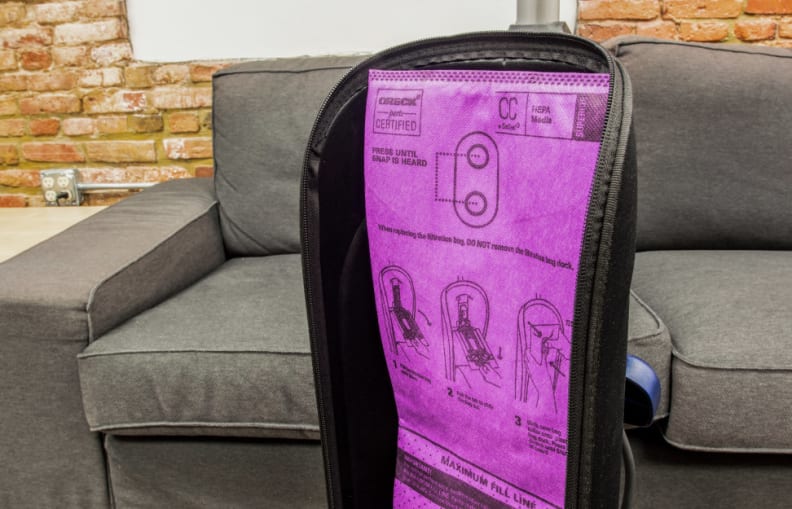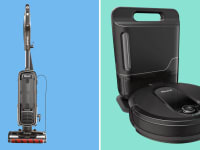Ever wonder about the 'vacuum' in vacuum cleaner? Here's how it works
It's all about the roller brush and the fan
 Credit:
Reviewed / Jonathan Chan
Credit:
Reviewed / Jonathan Chan
Recommendations are independently chosen by Reviewed's editors. Purchases made through the links below may earn us and our publishing partners a commission.
It’s likely that you don’t spend much time asking yourself “how does a vacuum work?” until it’s not working.
We’ve all experienced frustration with our vacuum cleaners, but the models of today have come a long way since the early days of this household appliance.
Uprights and canister vacuums are lighter, more maneuverable, and have more suction power than ever before.
In the past, if you wanted to clean your hardwood floors, you’d grab your broom and dustpan, not your vacuum. Handheld vacuums and shop vacs make the need to go to a car wash to clean out your vehicle a thing of the past, too.
And just a few decades ago, the best cordless stick vacuums and robot vacuums of today were things of science fiction.
Whether you’re doing a quick clean of the kitchen or a deep cleaning before your in-laws arrive for a visit, we’re fortunate that we have the power and ease of vacuums to help you clean your floors. But just how do these machines work?
A vacuum’s cleaning power is all thanks to two simple machines hidden underneath all that plastic molding: the roller brush and the fan.
The essential role of the roller brush

The roller brush makes it possible to get dirt out of carpets.
The roller brush is the combination of a belt, a roller, and sometimes a small vacuum head motor. The roller spins, and the bristles attached to it sweep up debris that then gets sucked into the dirt container of the vacuum. The brush head also helps to pull dirt and debris out of carpets of various pile heights.
The cylindrical shape of the roller brush is harnessed on at least one end by a rubber belt. This belt pushes and pulls the brush to make it spin. The other end of this belt is connected to another roller. This second roller is driven either by the motion of the wheels when you push the vacuum, or by a motor that causes the brush to rotate independently.
Big deal, you say. Who cares about the roller brush? It’s always covered in gross hair and other things you don’t want to investigate too closely. It’s also always the first part of the vacuum to break or come loose.
While it may not be fun to look at, carpet cleaning would not be possible without the roller brush. It performs two vital functions: It agitates the shallower parts of the carpet as the brush rolls. This loosens debris caught in the carpet fibers to escape from their nylon prisons and more easily come out of the carpet. The roller's bristles disturb the carpet fibers to create a more direct path for dirt trapped deep in the carpet to move toward the surface.
There’s a very good reason why shop vacuums aren’t used on carpet—a vacuum without a roller brush would do a terrible job of cleaning a carpet. The belt/roller combination of the roller brush is really the unsung hero of removing dirt from carpet.
The fan creates the vacuum cleaner's vacuum
A vacuum cleaner's fan is located in the body of the vacuum cleaner and is powered by a motor. When you turn your vacuum cleaner on, you’re switching on the motor, which drives the rotation of the fan blades and creates suction.
The fan in your vacuum operates under the same principles as your ceiling fan, except that it's much more compact and powerful. The blades of a fast ceiling fan rotate at rates up to about 300 rotations per minute, while a vacuum cleaner fan can get up to about 4,800.
In fact, the fan blows air out through the exhaust port in the vacuum cleaner at such a high speed that it creates a localized area completely devoid of air, also known as a vacuum.
Air rushes in the intake port just as rapidly to replace the lost air. It is this type of observation (albeit, not with a vacuum cleaner) that caused Aristotle to determine that “Nature abhors a vacuum.”
The normal air pressure outside wants to fill this low-pressure airless void however it can, so vacuum cleaner engineers seal all other access points in the vacuum cleaner head and hose. That way, the only way that replacement air can get in is through the vacuum head—or the end of a dust brush, crevice tool, or any other attachment, if you’re using one. If you’ve got the vacuum buried in carpet, that air is going to have to flow through the carpet to get in.
Therefore, the “sucking” force of a vacuum is really the continuous flow of air from an area of high air pressure (the carpet) to a low-pressure area (inside the vacuum cleaner). This pressure differential causes the replacement air to be pulled in so rapidly that both light debris (like dust and dander) and heavy debris (dirt in the carpet, or rice and macaroni in our testing lab) are pulled into the vacuum cleaner and caught in the filter and bag.
The fan and the roller brush work together
You can thank your vacuum's tiny fan for that powerful suction you're accustomed to, but remember that its co-worker—the roller brush—is just as important. The powerful airflow from the vacuum can help shake dirt and debris loose and pull them into the vacuum. Without the fan, a vacuum couldn’t work at all.
But the roller brush is critical, too. It’s necessary in dislodging deep dirt and stuck debris, and it helps clear a path for air to carry dirt into the vacuum.
It’s in the bag

An Oreck upright vacuum with a large, replaceable bag.
So the vacuum is rapidly pulling air into one end, and jetting it out of the other. That’s a good start, but you also need to contain the dirt, or else you’re just spewing dust all over our house. That’s where the bag—or the dirt container of a bagless vacuum—comes into play.
The vacuum’s bag is tightly sealed. It doesn’t just hold dirt, it also acts as a filter for the air coming out of the vacuum’s exhaust. You can even buy HEPA vacuum bags if you really want to ensure that only the cleanest air is coming out of your vacuum.
Bagless vacuum dirt containers
Bagless vacuums similarly trap dirt, but in a slightly different way. In these vacuums, the airstream spirals around inside the dirt container, like a tiny cyclone. The centrifugal force flings dirt to the outer edges of the container, away from the airstream.
However, there’s still a filter between the dirt container and the exhaust. Some high-end vacuums may even have an included or optional HEPA filter for extra-clean air.
Balance of power
Your vacuum has to do several jobs at once, in order to complete its task. It has to provide suction. Some have to manually spin the brush roller. Robot vacuums have to avoid obstacles and find paths.
In cordless, handheld, and robot vacuums, power is a limited resource. There’s a constant struggle between providing effective cleaning and good battery life. In a robot vacuum, some of that power also needs to go into processing navigational tasks.
While a battery isn’t exactly an integral part of a vacuum’s design, it’s a crucial consideration in many types of vacuums, and it’s something to think about when choosing one.
It takes a lot of moving parts to make a good vacuum cleaner. The motor, the spinning brush, and the dirt container all have to be just right to create a controlled stream of air that grabs and traps dirt and debris.
So the next time you lament having to grab your cordless vacuum, canister, or hand vacuum, just remind yourself that these two simple devices actually make carpet cleaning a lot easier than you think.
The product experts at Reviewed have all your shopping needs covered. Follow Reviewed on Facebook, Twitter, Instagram, TikTok, or Flipboard for the latest deals, product reviews, and more.
Prices were accurate at the time this article was published but may change over time.



